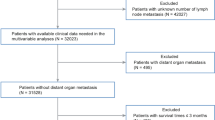Abstract
Background
Lymph node involvement is a very important prognostic factor for cutaneous melanoma. In this paper we try to validate a nomogram that was created at the Memorial Sloan–Kettering Cancer Center, New York, to predict the probability of metastases in the sentinel nodes of patients with cutaneous melanoma.
Methods
Values of the following variables were collected in 218 patients with cutaneous melanoma and sentinel lymph node: age, thickness, level of Clark, location of the lesion, and ulceration or not, and the nomogram was applied to assess the probability of sentinel node involvement in each patient. The discrimination of the nomogram was assessed by calculating the area under the receiver operating characteristics (ROC) curve, and to assess the accuracy of the nomogram actual probabilities were plotted against the nomogram-calculated predicted probability.
Results
The overall predictive accuracy of the nomogram was 0.869 (95% confidence interval 0.813–0.925). Mean predicted probability of sentinel node metastasis was highly correlated to the observed risk (r = 0.953; P < 0.012).
Conclusion
The nomogram is a useful diagnostic tool that provides an adequate accurate prediction of the probability of sentinel lymph node metastases in patients with cutaneous melanoma.


Similar content being viewed by others
References
TNM. Malignant tumors classification. In: Sobin LH, Wittekind Ch, eds. 6th edition, New York: Wiley, 2002
Thompson JF, Uren RF, Shaw HM, et al. Location of sentinel lymph nodes in patients with cutaneous melanoma: new insights into lymphatic anatomy. J Am Coll Surg 1999;189:195–206
Eberbach Ma, Wahl RL. Lymphatic anatomy: functional nodal basins. Ann Plast Surg 1989;22:25–31
Norman J, Cruse CW, Espinosa C, et al. Redefinition of cutaneous lymphatic drainage with the use of lymphoscintigraphy for malignant melanoma. Am J Surg 1991;162:432–7
Veronesi U, Adamus J, Bandiera DC, et al. Inefficacy of immediate node dissection in stage 1 melanoma of the limbs. N Eng J Med 1977;297:627–30
Sim FH, Taylor WF, Pritchard DJ, et al. Lymphadenectomy in the management of stage I malignant melanoma: a prospective randomized study. Mayo Clinic Proc 1986;61:697–705
Balch CM, Soong SJ, Bartolucci AA, et al. Efficacy of an elective regional lymph node dissection of 1 to 4 mm thick melanomas for patients 60 years of age and younger. Ann Surg 1996;224:255–66
Morton DL, Wen DR, Wong JH, et al. Technical details of intraoperative lymphatic mapping for early-stage melanoma. Arch Surg 1992;127:392–9
Doubrovsky A, de Wilt JHW, Scolyer RA, et al. Sentinel node biopsy provides more accurate staging than elective lymph node dissection in patients with cutaneous melanoma. Ann Surg Oncol 2006;11:829–36
Wong SL, Kattan MW, McMasters KM, et al. A nomogram that predicts the presence of sentinel lymph node metástasis in melanoma with better discrimination than the American Joint Committee on Cancer Staging System. Ann Surg Oncol 2005;12:282–8
Greene KL, Meng MV, Elkin EP, et al. Validation of the Catan preoperative nomogram for prostate cancer recurrence using a community based cohort: results from cancer of the prostate strategic urological research endeavor (capsure). J Urol 2004;171:2255–6
Yanke BV, Gonen M, Scardino PT, et al. Validation of a nomogram for predicting positive repeat biopsy for prostate cancer. J Urol 2005;173:421–4
Smidt ML, Kuster DM, van der Wilt GJ, et al. Can the Memorial Sloan-Kettering Cancer Center nomogram predict the likelihood of nonsentinel lymph node metastases in breast cancer patients in The Netherlands? Ann Surg Oncol 2005;12:1066–72
Lambert LA, Ayers GD, Hwang RF, et al. Validation of a breast cancer nomogram fro predicting nonsentinel lymph node metastases after a positive sentinel lymph node biopsy. Ann Surg Oncol 2006;13:310–20
Hanley JA, Mc Neil BJ. A method of comparing the areas under receiver operating characteristics curves derived from the same cases. Radiology 1983;148:839–43
Mraz-Gemhard S, Sagebiel RW, Kashani-Sabet M, et al. Prediction of sentinel node micrometastasis by histological features in primary cutaneous malignant melanoma. Arch Dermatol 1998;134:983–7
Sondak VK, Taylor JMG, Sabel MS, et al. Mitotic rate and younger age are predictors of sentinel lymph node positivity: lessons learned from the generation of a probabilistic model. Ann Surg Oncol 2004;11:247–58
Kesmodel SB, Karakousis CP, Botbyl JD, et al. Mitotic rate as a predictor of sentinel lymph node positivity in patients with thin melanoma. Ann Surg Oncol 2005;12:449–58
Dadras SS, Lange-Asschenfeldt B, Velasco P, et al. Tumor lymphangiogenesis predicts melanoma metastasis to sentinel lymph nodes. Mod Pathol 2005;18:1232–42
Piñero A, Martínez-Escribano J, Martínez-Barba E, et al. Are there factors that predict the result of selective sentinel lymph-node biopsy in melanoma? Rev Oncol 2004;6:283–8
Leong SP, Kashani-Sabet M, Desmond RA, et al. Clinical significance of occult metastatic melanoma in sentinel lymph nodes and other high-risk factors based on long-term follow-up. World J Surg 2005;29:683–91
Puleo CA, Messina JL, Riker AI, et al. Sentinel node biopsy for thin melanomas: which patients should be considered? Cancer Control 2005;12:230–5
Paek SC, Griffith KA, Johnson TM, et al. The impact of factors beyond Breslow depth on predicting sentinel lymph node positivity in melanoma. Cancer 2007;109:100–8
Mozzillo N, Caraco C, Chiofalo MG, et al. Sentinel lymph node biopsy in patients with cutaneous melanoma: outcome after 3-year follow-up. Eur J Surg Oncol 2004;30:440–3
Author information
Authors and Affiliations
Corresponding author
Rights and permissions
About this article
Cite this article
Piñero, A., Canteras, M., Ortiz, E. et al. Validation of a Nomogram to Predict the Presence of Sentinel Lymph Node Metastases in Melanoma. Ann Surg Oncol 15, 2874–2877 (2008). https://doi.org/10.1245/s10434-008-0077-x
Received:
Revised:
Accepted:
Published:
Issue Date:
DOI: https://doi.org/10.1245/s10434-008-0077-x




